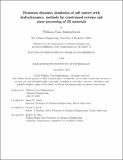Brownian dynamics simulation of soft matter with hydrodynamics: methods for constrained systems and shear processing of 2D materials
Author(s)
Funkenbusch, William Tian
DownloadThesis PDF (57.49Mb)
Advisor
Doyle, Patrick S.
Swan, James W.
Terms of use
Metadata
Show full item recordAbstract
2D materials are a rising class of soft matter material with a promising set of unique characteristics. The most ubiquitous 2D material, graphene, for example, possesses large surface areas, tunability, and unique electrical, optical, and catalytic properties while being lightweight, strong, and flexible. This has led to graphene seeing use in separations, biomedical applications, flexible electronics, and more. Meanwhile, synthetic 2D polymers, a relatively new field of study, represent a massive expansion of the design space for 2D materials and their applications. Solution processing of these materials is often an important step for synthesizing or applying them, necessitating knowledge of their behavior in suspensions and in flows. As these materials become more viable, our fundamental understanding of them must increase in tandem. This will inform us in designing these materials for our desired applications. However, especially when compared to their 1D counterparts, our understanding of 2D materials is lacking. It is the goal of this thesis to help fill in this gap in knowledge.
In Chapter 1, we discuss the basics of soft matter and methods for simulating which are the basis for understanding the work in this thesis. We present and discuss the governing equations for the movement of soft matter particles. We then discuss the simulation methodology and mobility tensor approximations used in this thesis along with some additional considerations.
In Chapter 2 we study methods for simulating constrained Brownian systems. We compare the current state-of-the-art method for these simulations, GMRES, to a different method called the projected conjugate gradient (PrCG) method. In particular, we compared PrCG and GMRES for rigid bodies, freely jointed chains, and immobile systems. We find that both methods exhibit the same linear computational complexity. We find that PrCG, however, exhibits some notable advantages over GMRES including lower precomputational and storage burdens, a guaranteed feasible iterate, and trivial extension to new constraint types due to the lack of a preconditioner. We use PrCG to solve a mixed constraint problem with rigid body and immobile particles, comparing to the analytical solution at large separations.
The remainder of this thesis studies the effects of self-attraction on self-avoiding, semi-flexible, athermal 2D materials (sheets) in shear flow. In Chapter 3, we give a background on rheology and 2D materials which are necessary for understanding the remaining chapters. We begin by discussing non-Newtonian fluids, specifically their applications and affect on the momentum balance presented in Chapter 1. Then, we give a brief introduction on simple shear and discuss how it is implemented in simulations. Finally, we give a brief introduction to 2D materials, their applications, as well as previous experimental, theoretical, and computational work.
In Chapter 4, we model self-interacting, self-avoiding, semi-flexible, athermal sheets in shear flow. We find a rich conformational landscape of 4 different behaviors --- flat, tumbling, 1D folded, and 2D folded --- which are well-delineated by several dimensionless groups representing the ratios between shear strength and interaction strength, and bending rigidity and interaction strength. We use these dimensionless groups to explain the observed behaviors, explain the folding behavior of 1D folded sheets, and calculate and explain the viscosity of a dilute suspension of these sheets. We use the conformational and rotational properties of the sheet simulations to explain this behavior, demonstrating a new explanation for the non-monotonic rheological properties of 2D materials which does not involve sheet-sheet interactions (which are rare in dilute suspensions) or thermal energy (which is often small in sheet systems). We also study systems with two initially stacked sheets in order to model, for example, shear exfoliation of 2D materials. We find three behaviors --- separating, waltzing, and flipping --- which are characterized by the same dimensionless groups as single sheets. We again explain these behaviors and calculate the viscosity of these sheets which again shows interesting non-monotonic rheological properties which we also explain using the conformational and rotational properties of the sheets.
In Chapter 5, we use simple time-dependent flow protocols to show how the properties of sheets can be controlled. Specifically, we use linear shear annealing simulations to show that the final conformational properties of a sheet suspension can be tuned continuously by varying the quench time. We also use our knowledge of the phase map of sheets to design flow protocols with step changes in shear rate to produce a target state of highly aligned, 1D folded sheets which represents, among other things, our predicted lowest possible viscosity for a sheet suspension.
In Chapter 6, we discuss potential future directions for the sheet model applied in Chapters 4 and 5. Specifically, we discuss loose ends from Chapter 4 and potential extensions of the model. We discuss potential benefits of and complications in exploring these directions.
Finally, in Chapter 7, we summarize the discoveries presented in this thesis and provide concluding remarks.
Date issued
2024-09Department
Massachusetts Institute of Technology. Department of Chemical EngineeringPublisher
Massachusetts Institute of Technology